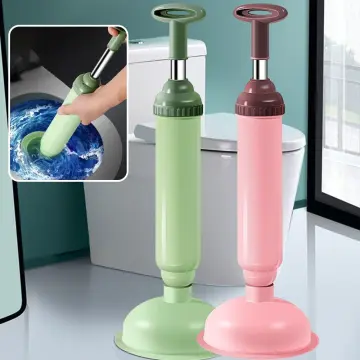We've stumbled on this great article about Here's How to Correctly Use a Toilet Plunger down the page on the internet and figured it made good sense to talk about it with you over here.
.jpg)
Intro
Appropriate maintenance of house drains is important for protecting against blockages and ensuring smooth water circulation. One of the secret tools in every house owner's toolkit is the plunger, together with various drain cleansers designed to deal with persistent obstructions successfully. This article checks out just how to use plungers and drainpipe cleansers properly to keep your drains streaming easily.
Area 1: Recognizing Plungers
Kinds of Plungers
There are numerous types of plungers available, each developed for different types of drains and clogs. The most usual kinds include mug bettors, flange bettors, and accordion bettors.
Exactly How Plungers Work
Plungers service the principle of developing stress and suction to displace blockages. When properly applied over a drainpipe, they produce a vacuum cleaner that can take out particles or separate blockages.
Picking the Right Bettor
Picking the appropriate bettor depends upon the type of drain and the nature of the obstruction. Cup plungers are excellent for sinks and tubs, while flange plungers are much better matched for toilets due to their style.
Typical Blunders with Bettors
Avoiding these mistakes guarantees efficient plunging: incorrect seal around the drainpipe, inadequate pressure, and unclear surrounding debris.
Section 2: Using Plungers Efficiently
Preparation
Before diving, make certain the bettor covers the drainpipe entirely and develops a limited seal. Clear any noticeable debris around the drain opening.
Strategy
Start with gentle diving motions to develop suction. Rise pressure slowly, making use of a steady rhythm. Repeat as needed until the drain removes.
Repairing Tips
If plunging doesn't work, try changing the seal, applying petroleum jelly for a better seal, or making use of a different kind of bettor.
Area 3: Comprehending Drainpipe Cleaning Company
Types of Drainpipe Cleaning Company
Drain cleansers can be chemical or enzymatic. Chemical cleaners utilize solid chemicals to dissolve clogs, while chemical cleansers make use of all-natural enzymes to break down organic matter.
How Drain Cleansers Job
Chemical cleansers respond with obstructions to liquify them, while chemical cleansers break down natural products like hair and oil without hurting pipes.
Security Considerations
Always wear gloves and eye defense when making use of chemical drainpipe cleansers. Make sure sufficient ventilation and follow supplier guidelines meticulously.
Eco-Friendly Alternatives
Take into consideration using vinegar and baking soda or enzyme-based cleaners for environment-friendly choices that are more secure for pipelines and the atmosphere.
Area 4: Utilizing Drain Cleaners Efficiently
Application Techniques
Put chemical cleansers straight right into the drainpipe opening. Enable them to benefit the suggested time prior to purging with warm water. Chemical cleaners must rest over night.
Safety measures
Prevent blending different kinds of cleansers, as this can generate harmful fumes. Never use chemical cleansers combined with a bettor, as spilling can take place.
Dealing With Persistent Obstructions
For relentless blockages, consider using a plumbing serpent or calling a specialist plumber to prevent damages to pipes.
Conclusion
Finally, recognizing just how to utilize bettors and drainpipe cleaners effectively is essential for keeping healthy and balanced plumbing systems. By choosing the right tools and strategies, house owners can tackle small blockages and avoid significant plumbing concerns down the line.
How To Properly Use A Plumbing Snake To Clear Drains
When any drain clogs in our home arise, we tend to gravitate toward the plunger and little else. In cases where the plunger and its vacuum-created pressure are not able to clear clogs, many immediately move to harmful chemicals or simply call their plumber to fix the issue.
we’re happy to help with all drain cleaning needs and concerns. This includes informing you on a few other home remedies you may have at your disposal for minor to moderate clogs, one of which is the use of a plumbing snake. Many people have never used one of these before – let’s go over the steps to take when your drain clogs and you have a plumbing snake available.
Attempt Plunger Use
The first step here, as we noted above, should indeed be to grab your plunger when you notice a drain clog and attempt to resolve it this way. If you’re unsure how to use a particular type of plunger, our plumbers can answer any questions you have. If this doesn’t do the trick, however, you move on to the snake.
Locate And Prepare Snake
A plumbing snake is a metal or plastic device that’s generally about a quarter of an inch thick. It’s design with significant extensions, meant to reach down into your clogged drain and push the clog out. Snakes also contain drain augers that will latch onto and push stubborn blockages.
If your plunger doesn’t clear a clog, locate your snake and bring it to the drain in question. We also recommend keeping a bucket nearby to collect the clog once you pull it out, plus we’d advise wearing goggles and possibly protective gloves.
Feed Snake
Once you’re ready to go, feed the snake slowly down the drain, using the crank device it comes with to keep it moving until it finds the clog. Once this happens, much of the clog will be latched onto the coil so you can pull it out, while the rest will simply break up and flow downward.
Detach Debris
Remove the snake slowly from the drain, and once you’ve done so, pick off any debris that’s stuck to the coil. This is another area where wearing gloves is a must.
Flush Drain
Finally, take a few minutes to ensure the snake has done its job correctly. If you’ve been using it on a toilet, flush the toilet a couple times and make sure everything flows well. If you’ve used it on a different drain, flush it with some room temperature water.
https://www.mybuddytheplumber.com/blog/how-to-properly-use-a-plumbing-snake-to-clear-drains/

Do you really like more info about Tips on How to Effectively Use a Plunger? Place feedback down the page. We'd be delighted to listen to your views about this entry. In hopes that you visit us again before long. Loved our content? Please quickly share it. Let someone else check it out. Many thanks for taking the time to read it.
Go Company
 Jake Lloyd Then & Now!
Jake Lloyd Then & Now! Judge Reinhold Then & Now!
Judge Reinhold Then & Now! Gia Lopez Then & Now!
Gia Lopez Then & Now! Richard Dean Anderson Then & Now!
Richard Dean Anderson Then & Now! Ryan Phillippe Then & Now!
Ryan Phillippe Then & Now!